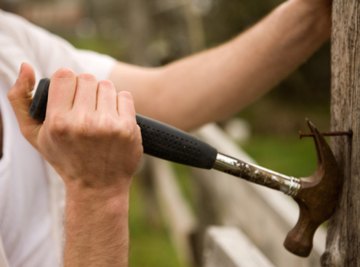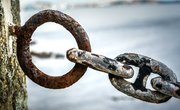
The silver shine of a new nail may begin to show reddish-brown spots eventually, especially when exposed to the elements for an extended amount of time. This is the familiar beginning of rusting. The causes of rusting are chemical and involve reactions with water and oxygen.
Chemical Causes of Rusting
The causes of corrosion require the presence of water and oxygen. Water can combine with carbon dioxide in the air to form carbonic acid, a weak acid.
When this acidic solution reaches iron, two reactions occur. First, the acidified water (a good electrolyte – more on this later) will dissolve some of the iron by removing electrons. Then, the water will begin to break down into hydrogen and oxygen. Free oxygen reacts with dissolved iron to form iron oxide, and iron oxide is rust.
From this explanation, a word equation for rust can be created:
Iron + water + oxygen → iron oxide (rust)
Resulting Chemical Reaction of Rust
The resulting chemical reaction of rusting is:
4Fe(s) + 3O2(g) + 6H2O(l)→ 4Fe(OH)3(s)
This porous rust, Fe(OH)3(s) reacts with additional oxygen to yield a more crystallized rust with a formula of Fe2O3 . xH20. The hydrated iron (III) oxide (Fe2O3) has water attached with approximately 3/2 H2O; the water amount is not fixed thus the x in front of the H20.
This reaction, however, happens in steps.
Electrochemical Process of Rust
Metals like iron dissolve in an electrochemical process. This means the process acts like an electrochemical cell (commonly thought of as a battery).
The anode will be a location where the metal is stressed or damaged. The cathode is another part of the metal not undergoing corrosion. Water acts as the electrolyte – the bridge – and transports ions to keep the flow of electrons moving, or, in this case, the flow of electrons that will corrode the anode area of the iron.
All electrochemical processes involve a type of chemical reaction called oxidation-reduction or redox reactions. In a redox reaction, there is a transfer of electrons. The transfer of electrons in corrosion are taken from the surface of the metal and transferred to suitable electron acceptors, like oxygen and hydrogen.
The Two-Step Chemical Reactions of Rust
Redox reactions can often be placed as half-reactions to see how the electrons are moving in the reaction. The oxidation half-reaction loses electrons, and the reduction half-reaction gains electrons.
When water comes in contact with iron, Fe, the iron loses electrons in an oxidation process:
- At the anode, oxidation half-reaction: Fe(s) → Fe2+(aq) + 2_e_-
Simultaneously, at the cathode, a reduction half-reaction may be:
- Reduction of oxygen gas: O2(g) + 2H2O(l) + 4e- → 4OH- (aq)
- Or the reduction of hydrogen: 2H+(aq) + 2e- → H2(g)
- Or the combination of both: O2(g) + 4H+(aq) + 4_e_- → 2H2O(l)
As hydrogen ions are consumed, the pH rises and becomes less acidic, and OH- ions appear in the water. These react to produce iron (II) hydroxides that will begin to precipitate out of solution:
2Fe2+(aq) + 4OH- (aq) → 2Fe(OH)2(s)
Occurrence of Rusting
Since both water and oxygen are readily available, rust will eventually happen, even in steel, an alloy composed mostly of iron. If left unstopped, the rusting will continue past small spots and cover the entire surface.
The clean lines of the nail’s original shape will give way to a scaly feature and then to small pits. Since the iron oxide is a bulkier molecule than the original iron, it takes up more space, and this distorts the shape of the nail as it rusts. This distorted shape also causes rusty hinges to stick and squeak.
Over time, rust will reach the core, and the piece of metal can be broken easily in one’s hands. Salt that has been dissolved in water is not one of the causes of rusting, but it does speed up the process.
References
About the Author
Rosann Kozlowski is currently a freelance writer and tutor. She has a Master's Degree in Chemistry from the University of Oregon and has previously worked in the pharmaceutical industry and has taught at the middle school, high school, and college levels.
Photo Credits
Jupiterimages/Photos.com/Getty Images
